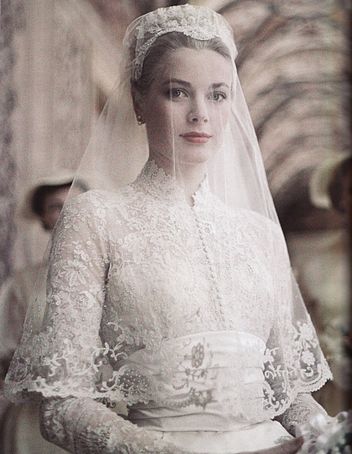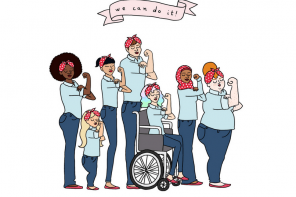Somewhere in the back of a dress shop, a heap of lace, buttons, and silk sits quietly on a table. Over the next couple of months, it will come together by the delicate hands of seamstresses to become the dress I will wear on my wedding day. I am having my dress handmade, because I discovered that finding a modest bridal gown is a rather impossible feat these days. After looking at dress after dress online and pushing back hanger after hanger at every nearby bridal store, I got the message: strapless and plunging are in, covering up on one’;s wedding day is not.
Even if I wanted to wear something strappy or fleshy, the Roman Catholic Church where I am getting married has strict guidelines for attire. In fact, I had to sign a paper agreeing that I will not wear something low-cut, strapless, or strappy.
In some ways, though, having my dress handmade made it more special and even convenient, as I’ve always known exactly what I want my dress to look like: a vintage lace collar, long-sleeves, pearly buttons, and a chapel train a la Grace Kelly.
Sixty years later, Grace Kelly remains an archetype of feminine grace, and the embodiment of virtue and modesty. She was a timeless beauty, a devout Roman Catholic, and a real princess. Many fondly referred to her as “Your Grace,” because she achieved the highly unusual feat of being both an American classic figure and European royalty, but also because she embodied the virtuous qualities of a woman of true grace.
At my first fitting, while I stood arms outstretched behind lush red drapes amidst chairs adorned with lace and satin, the seamstress giggled as she wrapped measuring tape around my body. “You must be a religious girl,” she said. “The dress you want simply cannot be found these days.” She went on to say that she herself is an Afghani Muslim, and the types of dresses worn by brides today would never fly in her religious community. How it came to be acceptable for women getting married to wear something “with their breasts on display” was beyond her. She said she often has young religious brides come her way, looking for something modest that embodies purity.
In fact, one of the dress pictures I had clipped for the designer was of a handmade, modest wedding gown made for an Orthodox Jewish bride. Wendy Shalit, author of A Return to Modesty; herself a Jew, refers to Jewish women who have chosen the modest life as the “modestyniks.” She writes that a modestynik is a woman who had “hitherto seemed perfectly normal but who, inexplicably, and without prior notice, starts wearing very long skirts and issuing spontaneous announcements that she is now shomer negiah, which means that she isn’t going to have physical contact with men before marriage, and that she is now dressing according to the standards of Jewish modesty.” She then goes on to write that said modestyniks are identifiable by the lightness in their step and the twinkle in their eyes.
In a culture where baring all is the trend, women of all faiths are united in our embrace of a more modest approach to attire, and to life. While it takes different variations, both across religions and within faith traditions, our commonality stems from a shared understanding that modesty directs attention away from our bodies and towards the deeper qualities that define who we are. Just as some Muslim women cover their heads and some don’t, some Catholic women wear the Mantilla to Mass, and some don’t. But we all see a common virtue in guarding our bodies, not just in what we wear, but in how we live. Modesty demands a certain degree of respect from men. When women draw attention to their bodies, they are asking to be defined by their bodies, and at some point, they will find themselves treated as if they were nothing more than a body.
Sometimes living modestly introduces extra challenges, wearing the latest fashions among them. But even the fashion world occasionally pines for a time past when clothing was more modest. Ivanka Trump asked Vera Wang to design her wedding gown with Grace Kelly as the inspiration. Wang welcomed the opportunity to design a dress that wasn’t what she termed, “naked and very Hollywood,” rather than taking offense that Trump did not ask for a traditional Vera Wang style. “Nothing would make me happier,” said Wang. “I’ve been doing strapless dresses for 15 years. It’s tiring.”
Today’s culture harps incessantly about women’s empowerment. But there are those of us who know that a woman’s inner princess is exalted through her outward modesty. The choice to dress and live modestly brings out the Grace Kelly in us all, Catholic, Jew, and Muslim alike.
Ashley Samelson blogs about faith, feminism, and politics at Rouge in Rouge
Photo Source: celebritybrideguide.com





